|
FOREWORD
"The last decades of the twentieth century have witnessed an upsurge
of human knowledge that boggles the mind. Our advances in every
field of science and technology are no longer measured in centuries
or even decades but in years and even months, and they seem to
surpass in attainments and scope anything that Man has achieved in
the past.
"But it is possible that Mankind has come out of the
Dark Ages and
the Middle Ages; reached the Age of Enlightenment; experienced the
Industrial Revolution; and entered the era of high-tech, genetic
engineering, and space flight - only to catch up with ancient
knowledge?
"For many generations the Bible and its teachings have served as an
anchor for a searching Mankind, but modern science appeared to have
cast us all adrift, especially in the confrontation between
Evolution and Creationism. In this volume it will be shown that the
conflict is baseless; that the Book of Genesis and its sources
reflect the highest levels of scientific knowledge.
"Is it possible, then, that what our civilization is discovering
today about our planet Earth and about our corner of the universe,
the heavens, is only a drama that can be called "Genesis Revisited"
- only a rediscovery of what had been known to a much earlier
civilization, on Earth and on another planet?
"The question is not one of mere scientific curiosity; it goes to
the core of Mankind’s existence, its origin, and its destiny. It
involves the Earth’s past; it deals with where we are going because
it reveals where we have come from. And the answers, as we shall
see, lead to inevitable conclusions that some consider too
incredible to accept and others too awesome to face.
Return
Chapter One
THE HOST OF
HEAVEN
In the beginning
God created the Heaven and the Earth.
"The very concept of a beginning of all things is basic to modern
astronomy and astrophysics. The statement that there was a void and
chaos before there was order conforms to the very latest theories
that chaos, not permanent stability, rules the universe. And then
there is the statement about the bolt of light that began the
process of creation.
"Was this a reference to the Big Bang, the theory according to which
the universe was created from a primordial explosion, a burst of
energy in the form of light, that sent the matter from which stars
and planets and rocks and human beings are formed flying in all
directions and creating the wonders we see in the heavens and on
Earth? Some scientists, inspired by the insights of our most
inspiring source, have thought so. But then, how did ancient Man
know the Big Bang theory so long ago? Or was this biblical tale the
description of matters closer to home, of how our own little planet
Earth and the heavenly zone called the Firmament, or "hammered-out
bracelet," were formed?
"....It is only appropriate that we begin the quest for answers
where the events began to unfold - in the heavens; where also, from
time immemorial, Man has felt that his origins, higher values -
God,
if you will - are to be found. As thrilling as discoveries made by
the use of microscopes are, it is what telescopes enable us to see
that fills us with the realization of the grandeur of nature and the
universe.
"....For the first time, perhaps, we can grasp the meaning and feel
the scope of the Psalmist’s words:
The heavens bespeak the glory of the Lord
an the vault of heaven reveals His handiwork.
"A fantastic era of planetary exploration came to a
magnificent
climax when, in August 1989, the unmanned spacecraft designated
Voyager 2 flew by distant Neptune and sent back to Earth pictures
and other data.
"....Thus it was that for several days at the end of August 1989,
headlines concerning another world pushed aside the usual news of
armed conflicts, political upheavals, sports results, and market
reports that make up Mankind’s daily life fare....
"....As the dazzling images of an aquamarine globe appeared on our
television screens, the commentators stressed repeatedly that this
was the first time that Man on Earth had ever really been able to
see this planet, which even with the best Earth-based telescopes is
visible only as a dimly lit spot in the darkness of space almost
three billion miles from us. They reminded the viewers that Neptune
was discovered only in 1846, after perturbations in the orbit of the
somewhat nearer planet Uranus indicated the existence of another
celestial body beyond it.... And thus not only the average TV viewer
but the astronomers themselves were about to see what had been
unseen before - it would be the first time we would learn the true
hues and makeup of Neptune.
"But two months before the August encounter, I had written an
article for a number of U.S., European, and South American monthlies
contradicting these long-held notions: Neptune was known in
antiquity, I wrote; and the discoveries that were about to be made
would only confirm ancient knowledge. Neptune, I predicted, would be
blue-green, watery, and have patches the color of "swamplike
vegetation"!
|
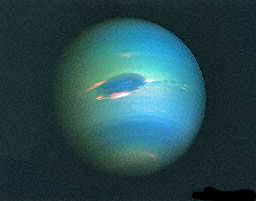
Neptune
|

Neptune’s both Hemispheres, above.
Neptune’s clouds, below.
|
|
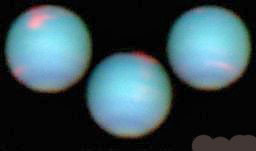 |
"The electronic signals from
Voyager 2 confirmed all that and
more....
"....This beautiful planet was found to be encircled by several
rings made up of boulders, rocks, and dust and is orbited by at
least eight satellites, or moons.... the largest, Triton, proved no
less spectacular than its planetary master....
|
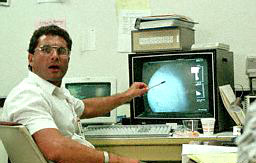
Viewing Triton at the JPL
|
"....The discoveries thus fully confirmed my prediction:
Neptune is
indeed blue-green; it is made up in great part of water; and it does
have patches whose coloration looks like "swamplike vegetation."
This last tantalizing aspect may bespeak more than a color code if
the full implication of the discoveries on
Triton is taken into
consideration: there, "darker patches with brighter halos" have
suggested to the scientists of NASA the existence of "deep pools of
organic sludge."
"....Such gratifying and overwhelming corroboration of my prediction
was not the result of a mere lucky guess. It goes back in 1976 when
The 12th Planet, my first book in
The Earth Chronicles series, was
published. Basing my conclusions on millennia-old Sumerian texts, I
had asked rhetorically: "When we probe Neptune someday, will we
discover that its persistent association with waters is due to the
watery swamps" that had once been seen there?
"This was published, and obviously written, a year before
Voyager 2
was even launched and was restated by me in an article two months
before the Neptune encounter.
"How could I be so sure, on the
eve of Voyager’s encounter with
Neptune, that my 1976 prediction would be corroborated - how dared I
take the chance that my predictions would be disproved within weeks
after submitting my article? My certainty was based on what happened
in January 1986, when Voyager 2 flew by the planet
Uranus.
"....Scientists are still
analyzing the photos and data from Uranus
and its amazing moons, seeking answers to endless puzzles.
-
Why does Uranus lie on its side as though it was hit by another large
celestial object in a collision?
-
Why do its winds blow in a
retrograde direction, contrary to what is normal in the Solar
System?
-
Why is its temperature on the side that its hidden from the
Sun the same as on the side facing the Sun?
-
And what shaped the
unusual features and formations on some of the Uranian moons?
Especially intriguing is the moon called
Miranda, "one of the most
enigmatic objects in the solar system," in the words of NASA’s
astronomers, where an elevated, flattened-out plateau is delineated
by 100-mile-long escarpments that form a right angle (a feature
nicknamed "the Chevron" by the astronomers), and where on both sides
of this plateau, there appear elliptical features that look like
racetracks ploughed over by concentric furrows.
"Two phenomena, however, stand out as the major discoveries
regarding Uranus, distinguishing it from other planets. One is its
color.... we have become familiar with the gray-brown of Mercury,
the sulphur-coloured haze that envelopes Venus, the reddish Mars,
the multihued red-brown-yellow Jupiter and Saturn. But as
breathtaking images of Uranus began to appear on television screens
in January 1986, its most striking feature was its greenish-blue
color - a color totally different from that of all the previous
planets seen.... The other different and unexpected finding had to
do with what Uranus is made of.
"As the images of
Uranus grew bigger on the TV screen the closer
Voyager 2 neared the planet, the moderator at the Jet Propulsion
Laboratory drew attention to its unusual green-blue color. I could
not help cry out loud, "Oh my God, it is exactly as the Sumerians
had described it!" I hurried to my study, picked up a copy of
The
12th Planet, and with unsteady hands looked at page 269 (in the Avon
paperback edition). I read again and again the lines quoting the
ancient texts. Yes, there was no doubt: though they had no
telescopes, the Sumerians had described Uranus as MASH.SIG, a term
which I had translated "bright greenish."
"A few days later came the results of the analysis of
Voyager 2’s
data, and the Sumerian reference to water on Uranus was also
corroborated. Indeed, there appeared to be water all over the place:
as reported on a wrap-up program on the television series NOVA ("The
Planet That God Knocked on Its Side"), "Voyager 2 found that all the
moons of Uranus are made up of rock and ordinary water ice." This
abundance, or even the mere presence, of water on the supposed
"gaseous" planets and their satellites in the edges of the Solar
System was totally unexpected.
"Yet here we had the evidence, presented in
The 12th Planet, that in
their texts from millennia ago the ancient Sumerians had not only
known of the existence of Uranus but had accurately described it as
greenish blue and watery!
"What did it all mean?
It meant that in 1986 modern science did not
discover what had been unknown; rather, it rediscovered and caught
up with ancient knowledge. It was, therefore, because of that 1986
corroboration of my 1976 writings and thus of the veracity of the
Sumerian texts that I felt confident enough to predict, on the eve
of the Voyager 2 encounter with Neptune, what it would discover
there.
|
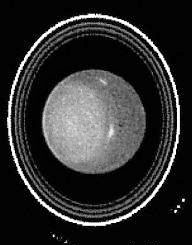
Uranus Rings
and Moons |
"....The 1989 flyby of
Neptune provided still more corroboration of
the ancient texts. In them, Neptune was listed before
Uranus, as it
would be expected of someone who is coming into the Solar System and
sees first Pluto, then Neptune, and then Uranus. In these texts or
planetary lists Uranus was called Kakkab shanamma, "Planet Which is
the Double" of Neptune. The Voyager 2 data goes far to uphold this
ancient notion. Uranus is indeed a look-alike of
Neptune in size,
color, and watery content; both planets are encircled by rings and
orbited by a multitude of satellites, or moons. An unexpected
similarity has been found regarding the two planets’ magnetic
fields: both have an unusually extreme inclination relative to the
planets’ axes of rotation - 58 degrees on Uranus, 50 degrees on
Neptune. "Neptune appears to be almost a magnetic twin of
Uranus," John Noble Wilford reported in The New York Times. The two planets
are also similar in the lengths of their days: each about sixteen to
seventeen hours long.
"...."Planet which is the double," the
Sumerians said of Uranus in
comparing it to Neptune. "Size and other characteristics that make
Uranus a near twin of Neptune," NASA’s scientists announced. Not
only the described characteristics but even the terminology -
"planet which is the double," "a near twin of Neptune" - is similar.
But one statement, the Sumerian one, was made circa 4,000 B.C., and
the other, by NASA, in A.D. 1989, nearly 6,000 years later...
"In the case of these two distant planets, it seems that modern
science has only caught up with ancient knowledge. It sounds
incredible, but the facts ought to speak for themselves. Moreover,
this is just the first of a series of scientific discoveries in the
years since The 12th Planet was published that corroborate its
findings in one instance after another.
"Those who have read my books (The
Stairway to Heaven, The Wars of Gods and Men, and The
Lost Realms, followed the first one) know that
they are based, first and foremost, on the knowledge bequeathed to
us by the Sumerians.
"....Indeed, all the basic elements of modern astronomy are of
Sumerian origin: the concept of a celestial sphere, of a horizon and
a zenith, of the circle’s division into 360 degrees, of a celestial
band in which the planets orbit the Sun, of grouping stars into
constellations and giving them the names and pictorial images that
we call the zodiac, of applying the number 12 to this zodiac and to
the divisions of time, and of devising a calendar to this very
day....
"....And there are illustrations on cylinder seals depicting the
Solar System in which the Sun (not Earth!) is in the center, orbited
by all the planets we know of today....
"....The ancient explanation regarding the origin of
Pluto reveals
not just factual knowledge but also great sophistication in matters
celestial. It involves an understanding of the complex forces that
have shaped the Solar System, as well as the development of
astrophysical theories by which moons can become planets or planets
in the making can fail and remain moons. Pluto, according to
Sumerian cosmogony, made it; our Moon, which was in the process of
becoming an independent planet, was prevented by celestial events
from attaining the independent status.
"Modern astronomers moved from speculation to the conviction that
such a process has indeed occurred in our Solar System only after
observations by the Pioneer and Voyager spacecraft.... in the words
of the Voyager’s project’s chief scientist Edward Stone, that
"Triton (Neptune’s moon) may have been an object sailing through the
Solar System several billion years ago when it strayed too close to
Neptune, came under its gravitational influence and started orbiting
the planet."
|

Edward Stone (lighter jacket) in this photo examining pictures of
Neptune. |
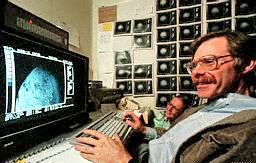
Examining Triton
|
"....Indeed, as we continue to expound the
Sumerian cosmogony, it
will become evident that not only is much of modern discovery merely
a rediscovery of ancient knowledge but that ancient knowledge
offered explanations for many phenomena that modern science has yet
to figure out.
"....How on Earth could the Sumerians have known all that so long
ago, at the dawn of civilization?
"The answer lies in the
second difference between the Sumerian
depiction of the solar System and our present knowledge of it (the
first difference, like Mr. Sitchin explains, is Pluto and its odd
orbit). It is the inclusion of la large planet in the empty space
between Mars and Jupiter. We are not aware of any such planet; but
the Sumerian cosmological, astronomical, and historical texts insist
that there indeed exists one more planet in our Solar System - its
twelfth member; they included the Sun, the Moon (which they counted
as a celestial body in its own right for reasons stated in the
texts), and ten, not nine planets. It was the realization that a
planet the Sumerian texts called
NIBIRU ("Planet of the Crossing")
was neither Mars nor Jupiter, as some scholars have debated, but
another planet that passes between them....
"....It is from that planet, the
Sumerians texts repeatedly and
persistently stated, that the ANUNNAKI came to Earth. The term
literally means "Those who from Heaven to Earth Came."
"....The advanced knowledge we find in Sumerian texts is thus, in
effect, knowledge that was possessed by the Anunnaki who had come
from Nibiru.... the Anunnaki came to Earth about 445,000 years ago.
Way back then they could already travel in space. Their vast
elliptical orbit made a loop - this is the exact translation of the
Sumerian term - around all the outer planets, acting as a moving
observatory from which the Anunnaki could investigate all those
planets.
"....On their planet Nibiru, the
Anunnaki/Nefilim were facing a
situation we on Earth may also soon face: ecological deterioration
was making life increasingly impossible. There was a need to protect
their dwindling atmosphere, and the only solution seemed to be to
suspend gold particles above it, as a shield. (Windows on American
spacecraft, for example, are coated with a thin layer of gold to
shield the astronauts from radiation).
"....The Sumerian texts that describe all these events and their
condensed version in the Book of Genesis have been extensively dealt
with in The 12th Planet.
"....Among the scientific advances that will be discussed in the
ensuing chapters will also be the mounting evidence for the
existence of Nibiru....
"....But after the publication of
The 12th Planet and the evidence
therein - which has not been refuted since its first printing in
1976 - and the evidence provided by scientific advances since then,
the discovery of Nibiru cannot remain just a matter involving
textbooks on astronomy. If what I have written is so - if, in other
words, the Sumerians were correct in what they were recording - the
discovery of Nibiru would mean not only that there is one more
planet out there but that there is Life out there. Moreover, it
would confirm that there is intelligent beings out there - people
who were so advanced that, almost half a million years ago, they
could travel in space; people who were coming and going between
their planet and Earth every 3,600 years.
"It is who is out there on
Nibiru, and not just its existence, that
is bound to shake existing political, religious, social, economic,
and military orders on Earth. What will the repercussions be when -
not if - Nibiru is found?
"It is a question, believe it or not, that is already being
pondered.
Return
Chapter Two
IT CAME FROM
OUTER SPACE
"It was Voyager [project] that
focused our attention on the
importance of collisions," acknowledged Edward Stone of the
California Institute of Technology (Caltech), the chief scientist of
the Voyager program. "The cosmic crashes were potent sculptors of
the Solar System."
"The Sumerians made clear, 6,000 years earlier, the very same fact.
Central to their cosmogony, worldview, and religion was a
cataclysmic event that they called the Celestial Battle.
"....Even more important, whenever these modern scientists have come
upon a satisfactory answer - it fits and corroborates the Sumerian
one!
"....The realization that there had to be one or more major
collisions that changed the Solar System from its initial form
became inescapable after the Uranus flyby in 1986, as
Dr. Stone has
admitted. That Uranus was tilted to its side was already known from
telescopic and other instrumental observations even before the
Voyager encounter. But was it formed that way from the very
beginning, or did some external force - a forceful collision or
encounter with another major celestial body - bring about the
tilting?
"The answer had to be provided by the close-up examination of the
moons of Uranus by Voyager 2. The fact that these moons
swirl around
the equator of Uranus in its tilted position.... made scientists
wonder whether these moons were there at the time of the tilting
event, or whether they formed after the event, perhaps from matter
thrown out by the force of the collision that tilted Uranus.
"....findings by
Voyager 2 were not the only clues suggesting that
the moons of Uranus were not formed at the same time as the planet
itself but rather some time later, in unusual circumstances. Another
discovery that puzzled the scientists was that the rings of Uranus
were pitch-black, "blacker than coal dust," presumably composed of
"carbon-rich material, a sort of primordial tar scavenged from outer
space" (the emphasis is Mr. Sitchin’s). These dark rings, warped,
tilted and "bizarrely elliptical," were quite unlike the symmetrical
bracelets of icy particles circling Saturn. Pitch-black also were
six of the moonlets discovered at Uranus, some acting as "shepherds"
for the rings. The obvious conclusion was that the rings and
moonlets were formed from the debris of a "violent event in Uranus’s
past.... "A likely possibility is that an interloper from outside
the Uranus system came in and struck a once larger moon sufficiently
hard to have fractured it."
"....In simpler words, it means that in all probability the moons in
question were created as a result of the collision that knocked
Uranus on its side. In press conferences the NASA scientists were
more audacious. "A collision with something the size of Earth, travelling at about 40,000 miles per hour, could have done it," they
said, speculating that it probably happened about four billion years
ago.
"Astronomer Garry Hunt of the Imperial College, London, summed it up
in seven words: "Uranus took an almighty bang early on."
"But neither in the verbal briefings nor in the long written reports
was an attempt made to suggest what the "something" was, where it
had come from, and how it happened to collide with, or bang into
Uranus.
"For those answers, we will have to go back to
the Sumerians. . . .
"Before we turn from knowledge acquired in the late 1970s and 1980s
to what was known 6,000 earlier, one more aspect of the puzzle
should be looked into: Are the oddities at Neptune the result of
collisions, or "bangs," unrelated to those of Uranus - or were they
all the result of one catastrophic event that affected all the outer
planets?
"Before the Voyager 2 flyby of Neptune, the planet was known to have
only two satellites, Nereid and Triton.
Nereid was found to have a
peculiar orbit: it was unusually tilted compared with the planet’s
equatorial plane (as much as 28 degrees) and was very eccentric -
orbiting the planet not in a near-circular path but in a very
elongated one, which takes the moon as far as six million miles from
Neptune and as close as one million miles to the planet.
Nereid,
although of a size that by planetary-formation rules should be
spherical, has an odd shape like that of a twisted doughnut. It also
is bright on one side and pitch-black on the other....
"The
dark material that shows up on one side of Nereid could be
explained in one of two ways - but both require a collision in the
scenario. Either an impact on one side of the satellite swept off an
existing darker layer there, uncovering lighter material below the
surface, or the dark matter belonged to the impacting body and "went
splat on one side of Nereid." That the latter possibility is the
more plausible is suggested by the discovery, announced by the
JPL
team on August 29, 1989, that all the new satellites (six more)
found by Voyager 2 at Neptune "are very dark" and "all have
irregular shapes,"....
"The theories regarding
Triton and its elongated and retrograde
(clockwise) orbit around Neptune also call for a collision event.
"....The data collected by Voyager 2 from the actual flyby of
Triton
supported this theoretical conclusion. It also was in accord with
other studies (as by David Stevenson of Caltech) that showed that
Triton’s internal heat and surface features could be explained only
in terms of a collision in which Triton was captured into orbit
around Neptune.
""Where did these impacting bodies come from?" rhetorically asked
Gene Shoemaker, one of NASA’s scientists, on the
NOVA television
program. But the question was left without an answer.
"....The
Sumerian texts speak of a single but comprehensive event.
Their texts explain more than what modern astronomers have been
trying to explain regarding the outer planets. The ancient texts
also explain matters closer to home, such as the origin of the Earth
and its Moon, of the Asteroid Belt and the comets. The text then go
on to relate a tale that combines the credo of Creationists with the
theory of Evolution, a tale that offers a more successful
explanation than either modern conception of what happened on Earth
and how Man and his civilization came about.
For the rest of this chapter
Mr. Sitchin presents the Celestial
Battle in a very rich description, with charts and graphics, with
which if you are not familiar, then you may view on these pages by
going to The 12th Planet.
Mr. Sitchin then ends:
"Modern astronomy and recent discoveries uphold and corroborate this
millennia-old tale.
Return
|






